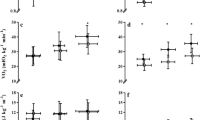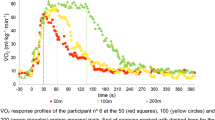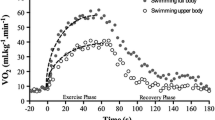Abstract
In supra-maximal exercise to exhaustion, the critical velocity (cv) is conventionally calculated from the slope of the distance (d) versus time (t) relationship: d = I + St. I is assumed to be the distance covered at the expense of the anaerobic capacity, S the speed maintained on the basis of the subject’s maximal O2 uptake \((\dot{V}\hbox{O}_{\rm 2max}).\) This approach is based on two assumptions: (1) the energy cost of locomotion per unit distance (C) is constant and (2) \(\dot{V}\hbox{O}_{2\rm{max}}\) is attained at the onset of exercise. Here we show that cv and the anaerobic distance (d anaer) can be calculated also in swimming, where C increases with the velocity, provided that \(\dot{V}\hbox{O}_{2\rm{max}},\) its on-response, and the C versus v relationship are known. d anaer and cv were calculated from published data on maximal swims for the four strokes over 45.7, 91.4 and 182.9 m, on 20 elite male swimmers (18.9 ± 0.9 years, 75.9 ± 6.4 kg), whose \({\dot{V}}\hbox{O}_{2\rm{max}}\) and C versus speed relationship were determined, and compared to I and S obtained from the conventional approach. cv was lower than S (4, 16, 7 and 11% in butterfly, backstroke, breaststroke and front crawl) and I (=11.6 m on average in the four strokes) was lower than d anaer. The latter increased with the distance: average, for all strokes: 38.1, 60.6 and 81.3 m over 45.7, 91.4 and 182.9 m. It is concluded that the d versus t relationship should be utilised with some caution when evaluating performance in swimmers.





Similar content being viewed by others
References
Alvarez-Ramirez J (2002) An improved Peronnet–Thibault mathematical model of human running performance. Eur J Appl Physiol 86:517–525
Billat LV, Koralsztein JP, Morton RH (1999) Time in human endurance models. From empirical models to physiological models. Sports Med 27:359–379
Binzoni T, Ferretti G, Schenker K, Cerretelli P (1992) Phosphocreatine hydrolysis by 31P-NMR at the onset of constant-load exercise in humans. J Appl Physiol 73:1644–1649
Busso T, Chatagnon M (2006) Modelling of aerobic and anaerobic energy production in middle-distance running. Eur J Appl Physiol 97:745–754
Capelli C, Termin B, Pendergast DR (1998) Energetics of swimming at maximal speed in humans. Eur J Appl Physiol 78:385–393
Chatagnon M, Busso T (2006) Modelling of aerobic and anaerobic energy production during exhaustive exercise on a cycle ergometer. Eur J Appl Physiol 97:755–760
Dekerle J, Sidney M, Hespel JM, Pelayo P (2002) Validity and reliability of critical speed, critical stroke rate, and anaerobic capacity in relation to front crawl swimming performances. Int J Sports Med 23:93–98
di Prampero PE (1981) Energetics of muscular exercise. Rev Physiol Biochem Pharmacol 89:143–222
di Prampero PE (1999) The concept of critical velocity, a brief analysis. Eur J Appl Physiol 80:162–164
Hill DW (1993) The critical power concept. A review. Sports Med 16:237–254
Holmer I (1972) Oxygen uptake during swimming in man. J Appl Physiol 33:502–509
Kjendlie PL, Ingjer F, Madsen O, Stallman RK, Gunderson JS (2004) Differences in the energy cost between children and adults during front crawl swimming. Eur J Appl Physiol 91:473–480
Lloyd BB (1966) The energetics of running: an analysis of word records. Adv Sci 22:515–530
Medbo JI, Tabata I (1993) Anaerobic energy release in working muscle during 30 s to 3 min of exhausting bicycling. J Appl Physiol 75:1654–1660
Montpetit RR, Lavoie JM, Cazorla GA (1983) Aerobic energy cost of swimming the front crawl at high velocity in international class and adolescent swimmers. In: Hollander AP, Huijing PA, de Groot G (eds) Biomechanics and medicine in swimming. Human Kinetics, Champaign, pp 228–234
Montpetit R, Cazorla G, Lavoje JM (1988) Energy expenditure during front crawl swimming: a comparison between males and females. In: Ungherechts BE, Wilke K, Reischle K (eds) Swimming science, vol V. Human Kinetics, Champaign, pp 229–236
Morton RH (2006) The critical power and related whole-body bioenergetic models. Eur J Appl Physiol 96:339–354
Pendergast DR, di Prampero PE, Craig AB, Wilson D, Rennie W (1977) Quantitative analysis of front crawl in men and women. J Appl Physiol 43:475–479
Peronnet F, Thibault G (1989) Mathematical analysis of running performance and world running records. J Appl Physiol 67:453–465
Scherrer J, Monod H (1960) Le travail musculaire local et la fatigue chez l’homme. J Physiol (Paris) 52:419–501
Termin B, Pendergast DR (2001) Training using the stroke frequency–velocity relationship to combine biomechanical and metabolic paradigms. J Swim Res 14:9–17
Toussaint HM (1990) Differences in propelling efficiency between competitive and triathlon swimmers. Med Sci Sports Exerc 22:409–415
Vandewalle H, Vautier JF, Kachouri M, Lechevalier JM, and Monod H (1997) Work-exhaustion time relationships and the critical power concept: a critical review. J Sports Med Phys Fit 37:89–102
Wakayoshi K, Yoshida T, Udo M, Kasai T, Moritani T, Mutoh Y, Miyashita M (1992) A simple method for determining critical speed as swimming fatigue threshold in competitive swimming. Int J Sports Med 13:367–371
Wilkie DR (1980) Equations describing power input by humens as a function of duration of exercise. In: Cerretelli P, Whipp BJ (eds) Exercise bioenergetics and gas exchange. Elsevier, Amsterdam, pp 75–80
Zamparo P, Capelli C, Cautero M, Di Nino A (2000) Energy cost of front crawl swimming at supramaximal speeds and underwater torque in young swimmers. Eur J Appl Physiol 83:487–491
Zamparo P, Pendergast DR, Mollendorf J, Termin A, Minetti AE (2005) An energy balance of front crawl. Eur J Appl Physiol 94:134–144
Author information
Authors and Affiliations
Corresponding author
Rights and permissions
About this article
Cite this article
di Prampero, P.E., Dekerle, J., Capelli, C. et al. The critical velocity in swimming. Eur J Appl Physiol 102, 165–171 (2008). https://doi.org/10.1007/s00421-007-0569-6
Accepted:
Published:
Issue Date:
DOI: https://doi.org/10.1007/s00421-007-0569-6




